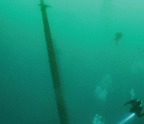USS CONESTOGA : ONCE LOST, NOW FOUND



On March 25, 1921, the fleet tug USS Conestoga steamed out past the Golden Gate on the first, long leg of an extended voyage to Pearl Harbor, and from there to American Samoa. The eighteen-year-old veteran tugboat, fresh from repairs at Mare Island Naval Shipyard on San Francisco Bay, carried with it fifty-six men. After passing the Golden Gate and then, twenty-six miles out, the flashing beacon of the lighthouse on Southeast Farallon Island, Conestoga entered the vast openness of the Pacific and disappeared. The disappearance of the tug and its crew was not immediately noticed. Conestoga was due at Pearl Harbor on or around April 5. When anxious family members began writing the Navy, inquiring why they had not heard from husbands, fathers, sons, brothers and uncles, Navy officials belatedly realized that the tug had never reached Hawaii.
By mid-May, the Navy commenced a vast search that reached out some five hundred miles from Hawaii, but with no success. The Navy searched there because a garbled radio message, thought to be from the tug, noted it had lost its tow and was headed into port. Then, following the report that the steamship Senator had found a lifeboat drifting off Mexico’s Baja California coast with a large brass letter “C,” the Navy launched a second search with ships and airplanes there, thousands of miles from Hawaii. Again, no trace of Conestoga or its crew was found by the searchers. On June 30, 1921, the Navy announced that Conestoga was lost at sea and the crew declared dead as of April 30.
The disappearance of one of only four Navy ships lost without a trace in peacetime in the 20th century, remained one of the great mysteries of the sea, and until well after World War II, old hands or that its tow, a Navy barge, had dragged it down. Other, more vicious theories and rumors suggested that the commanding officer, a former enlisted man, was not a competent seaman, or that its communist-sympathizing crew had hijacked and taken it to the Soviet Pacific port of Vladivostok. Neither, as would later be seen, were true.
You’re reading a preview, subscribe to read more.
Start your free 30 days



